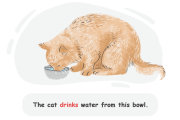Present Simple For beginners
In this lesson, beginners will learn about English Present Simple Tense with easy explanations, clear examples, and practice exercises.

What Is Present Simple Tense?
The present simple tense in English is the root of the verb without any ending and is used to talk about actions or situations that are regular or always true.
Spelling
In the simple present tense, the third-person singular form (he, she, it) of most verbs is formed by adding 's' to the base form of the verb. For example:
eat → eats
walk → walks
run → runs
If a verb ends in '-ch', '-ss', '-sh', '-x' or '-zz', add '-es' instead of 's':
watch → watches
wash → washes
mix → mixes
If a verb ends in a consonant + -y, change 'y' to 'i' and then add '-es':
study → studies
hurry → hurries
If a verb ends in a vowel + '-y', just add '-s':
pay → pays
enjoy → enjoys
Some verbs are irregular and their third-person form does not follow these rules. For example:
be → is
have → has
Present Simple 'to be'
The verb to be is one of the irregular verbs in English. In the table below, you can see its forms in the present simple tense:
Subject | Be |
|---|---|
I | am |
You | are |
He/She/It | is |
We | are |
You | are |
They | are |
Negation
To make a negative sentence, add 'do not' (don't) or 'does not' (doesn't) before the base form of verbs.
Affirmative | Negative | Short Form |
|---|---|---|
I go to school. | I do not go to school. | I don't go to school. |
You work. | You do not work. | You don't work. |
She runs. | She does not run. | She doesn't run. |
To negate a 'to be' verb, simply add 'not' after it. For example:
Affirmative | Negation | Short Form |
|---|---|---|
I am a student. | I am not a student. | - |
You are a student. | You are not a student. | You aren't a student. |
He/she is a student. | He/she is not a student. | He/she isn't a student. |
Questions
To make a yes/no question, use 'do/ does + subject + the base form of the verb' at the beginning of the sentence.
Statement | Question |
|---|---|
I run. | Do I run? |
You run. | Do you run? |
He goes to school. | Does he go to school? |
If the main verb of the sentence is 'to be', the question form is made by putting the verb at the beginning of the sentences and putting the subject after it.
Statement | Question |
|---|---|
I am happy. | Am I happy? |
You are a doctor. | Are you a doctor? |
He is nice. | Is he nice? |


Uses
The simple present tense is used to:
Talk about facts:
Mary has a twin sister.
The earth is round.
Talk about routines:
Mary goes to school every day.
I wash the dishes after dinner every night.
Quiz:
Which sentence is correct in the present simple tense?
She watchs TV every evening.
He go to the gym on Mondays.
He washes his car every weekend.
She mix the colors carefully.
Match the following words, phrases, or examples to their correct category in the Present Simple tense for third-person singular subjects:
Which option uses the negative present simple verb correctly?
They don't work here.
She don't likes apples.
I doesn't enjoy reading.
He doesn't eats breakfast.
What is the correct question form for this statement: "You play the guitar"?
Does you play the guitar?
Do you plays the guitar?
Do you play the guitar?
Do you playes the guitar?
Sort the words to form a yes/no question in the present simple tense.
Fill the blanks with the correct forms of the verbs in parenthesis in the Present Simple tense:
| subject | verb |
|---|---|
you | (run) |
she | (watch) |
It | (fly) |
they | (laugh) |
Comments
(0)